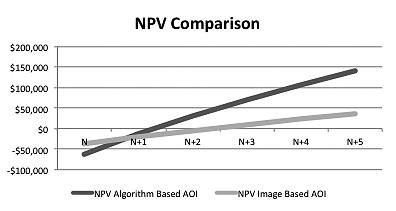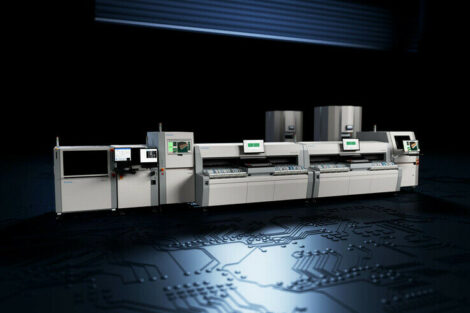Installed for the first time 20+ years ago, automated optical inspection has become an essential part of our SMT environment. In this article (first part October 2013) we explained the key functions of AOI machines. Most process engineers are turning to AOI as an strategy for addressing quality and productivity issues, and process control as well. The number of machine suppliers has grown and is creating the difficult task of choosing an machine that meets the requirements. In this article part II we provide potential users with guidance and better understanding of AOI by examining the technologies within and shedding light upon the costs involved; including purchase, equipment operation and long-term ownership.
Jean-Marc Peallat, Russ Warncke, Marc Brun, Vi Technology, Inc., Richardson/TX, USA
The first part of this article is dedicated to the “fundamentals of AOI”, best understood by examining current solutions from the perspective of the two prevailing, but different, technologies: image-based AOI and algorithm-based AOI. Each technology contributes a value to the inspection process that can be shown to be different. This value difference is highlighted by “key factors” which have a clear impact on the end user’s process. These key factors also are the main considerations when calculating return on investment (ROI). ROI calculations are shown as examples of the differences between image and algorithm-based AOI.
Every AOI process starts with a digital image from an acquisition chain (camera, lighting, lens). The resulting picture represents a scene (objects, shapes, background), and actually is a matrix of, with a single pixel being the smallest unit of the entire image. When comparing AOI solutions, people judge the quality of an image by pixel size (usually expressed in microns). The optics, camera and lighting play a key role in all AOI machines, but the real differentiator resides in the vision software tools that can be applied to captured images. To avoid an endless list of categories by detailing each and every tool available, a way to categorize machines is by comparing image-based to algorithm-based AOI.
Image-based technologies qualify a component by comparing its image to a collection of known good and bad images. The variety of comparison techniques range from the basic to neuronal networks, but the core question using an image-based AOI is the same: does the current image look like one stored in the image bank? By making its comparison, the machine will either respond with: “Yes, it is a good component,” or “No, I must compare to the next image in the bank.” The comparison process continues until the component is failed or a suitable match is made. (for more details see the ROI paragraph).
Using mathematics and geometry, algorithm-based AOI systems employ pattern recognition techniques to locate a component within an image. Instead of comparing one image to another, this technology uses a defined pattern (geometry or skeleton of the object) to find it in the picture. This is very powerful technology because the component is defined only by its shape, regardless of gray scale or pixel information. Algorithm technology also offers better accuracy because there is no need for pixel matching, and changes in the process environment have no adverse effect.
On the other hand, algorithm-based AOI measures the component with reference to the CAD data and criteria that are not dependent on any learned characteristics. This system relies on the real component’s geometric shape as defined in CAD, and provides accurate and repeatable data to supply to the process control software. Algorithm machines have been used since 2002 for process and closed-loop control. They remain the system of choice for manufacturers who require rigorous process control parameters for their assembly lines.
The facts on ROI
The value of any AOI is in improving and maintaining quality in the manufacturing process by reducing the overall number of defects. In order to measure the amount of value an AOI can provide, we calculate ROI (return on investment), including all costs directly linked to the system and all savings that can be achieved at inspection and rework, plus reduction of field returns occurring after AOI installation.
ROI calculations often are complex, so for this purposes we offer a simplified approach which does not include all possible savings (e.g. ICT coverage reduction). This simplified ROI should provide a fair comparison of both categories of AOI technology. This method is called net present value (NPV), which sums all the cash flows linked to the investment, costs and savings for a period of 5 years (a common depreciation period). The procedure provides a simple comparison using the following assumptions for both AOI technologies:
- Average sale price of image-based AOI is significantly lower than algorithm-based AOI (50% lower in that case)
- No engineering required for image AOI
- Engineering required for algorithm AOI (20% of full time engineer, for 5 years)
- 1 full-time operator for image AOI (for 5 years)
- With algorithm AOI full-time attention is not needed (20% of full time operator for 5 years). Most of the time, line operator acts as AOI operator as well.
- Yield improvement on algorithm-based is 20% higher than an image-based machine (process dependent)
Given these conditions and despite a heavier upfront investment, the algorithm-based AOI is able to generate up to $140,000 in savings over 5 years, compared with only $35,000 using an image-based machine. Moreover, running the same calculation and assuming that quality improvement will be the same for both types of AOI machines, the algorithm-based remains a better investment than the image-based system because it reduces defects and shows a lower cost of ownership. Reviewing overall costs and savings shows that the reduced upfront investment is not in the best interest for the customer from either a savings or quality standpoint.
Conclusion
Because there are many AOI choices from various manufacturers, any company looking to add or replace inspection technology would be well-served to come back to these basics:
- Technology
- Quality improvement
- Return on investment
These basic elements represent the real added value of an AOI system to a user’s process. They provide users the fundamental tools for selecting the right equipment, and their impact on successful AOI implementation. A quick system demonstration showing fast programming and implementation does not reveal the true costs of long-term AOI ownership and how much effort is needed for efficient process improvement.
zusammenfassung
In diesem zweiteiligen Grundlagenbeitrag über AOI vergleichen wir die Vor- und Nachteile von Image-basierenden sowie Algorithmen-basierenden Systemen. Wie im Teil Zwei hier dokumentierte Berechnung des Return of Investment (ROI) zeigt, ist trotz höherer Einstandskosten die Algorithmen-AOI über eine längere Nutzungszeit die Lösung, die erhebliche Kostenvorteile bringt. Zudem ist mit deren klaren Meßergebnissen auch wesentlich effizientere Prozesskontrolle sowie Qualitätssicherung möglich, was zu weiteren erheblichen Vorteilen führt.
Dans cette contribution de base en deux parties au sujet d’AOI, nous comparons les avantages et les inconvénients des systèmes basés sur des images ainsi que des systèmes basés sur des algorithmes. Comme le démontre ici dans la deuxième partie le calcul argumenté du retour sur investissement (ROI), et malgré des coûts initiaux plus élevés, l’algorithme AOI constitue pour une période d’utilisation plus longue, la solution qui apporte des avantages considérables en matière de coûts. De plus avec ses résultats de mesures clairs, il est également possible d’obtenir des processus de contrôle beaucoup plus efficaces ainsi qu’une assurance de qualité, ce qui entraîne d’autres avantages considérables.
Share:










